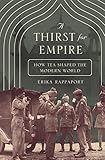A Thirst for Empire : How Tea Shaped the Modern World / Erika Rappaport.
Material type: TextPublisher: Princeton, NJ : Princeton University Press, [2017]Copyright date: ©2018Description: 1 online resource (568 p.) : 53 halftones. 7 tables. 3 mapsContent type:
TextPublisher: Princeton, NJ : Princeton University Press, [2017]Copyright date: ©2018Description: 1 online resource (568 p.) : 53 halftones. 7 tables. 3 mapsContent type: - 9780691192703
- 9781400884858
- History, Modern
- Imperialism -- Social aspects -- History
- Tea -- History
- Tea -- Social aspects -- History
- HISTORY / World
- Activism
- Advertising agency
- Advertising campaign
- Advertising
- Agriculture (Chinese mythology)
- Agriculture
- Americans
- Assam
- Auction
- Black tea
- Brand
- British Empire
- British firms (organised crime)
- Britishness
- Brooke Bond
- Capitalism
- Catering
- Cess
- Chain store
- Chairman
- China
- Chinese tea
- Coca-Cola
- Coffeehouse
- Colonialism
- Commodity
- Consumer behaviour
- Consumer revolution
- Consumer
- Consumerism
- Customer
- Decolonization
- Department store
- Drink
- Economic nationalism
- Economics
- Economy
- Empire Marketing Board
- Employment
- Food science
- Free trade
- Globalization
- Green tea
- Grocery store
- Household
- Housewife
- Ideology
- Imperialism
- Indian Tea Association
- Industrialisation
- Kenya
- Laborer
- Lipton
- Marketing
- Mass market
- Meal
- Metropole
- Modernity
- Mr
- Newspaper
- Opium
- Oxford University Press
- Political economy
- Politician
- Politics
- Popular culture
- Publication
- Publicity
- Racism
- Rationing
- Restaurant
- Retail
- Shopkeeper
- Shopping
- Shortage
- Slavery
- South Asia
- Southern Africa
- Sri Lanka
- Supply (economics)
- Sweet tea
- Tariff
- Tax
- Tea (meal)
- Tea culture
- Tea garden
- Tea in the United Kingdom
- Tea production in Sri Lanka
- Tea table
- Tea
- Teapot
- The Grocer
- Trade association
- Twinings
- United States
- Victorian era
- World War I
- World War II
- World economy
- World history
- online - DeGruyter
| Item type | Current library | Call number | URL | Status | Notes | Barcode | |
|---|---|---|---|---|---|---|---|
 eBook
eBook
|
Biblioteca "Angelicum" Pont. Univ. S.Tommaso d'Aquino Nuvola online | online - DeGruyter (Browse shelf(Opens below)) | Online access | Not for loan (Accesso limitato) | Accesso per gli utenti autorizzati / Access for authorized users | (dgr)9781400884858 |
Browsing Biblioteca "Angelicum" Pont. Univ. S.Tommaso d'Aquino shelves, Shelving location: Nuvola online Close shelf browser (Hides shelf browser)

|

|

|

|

|

|

|
||
| online - DeGruyter The Story of Hebrew / | online - DeGruyter Walk the Trails in and around Princeton : Revised to Include the Newest Trails / | online - DeGruyter Cents and Sensibility : What Economics Can Learn from the Humanities / | online - DeGruyter A Thirst for Empire : How Tea Shaped the Modern World / | online - DeGruyter Masters of Craft : Old Jobs in the New Urban Economy / | online - DeGruyter Decolonization : A Short History / | online - DeGruyter The Beginning of Politics : Power in the Biblical Book of Samuel / |
Frontmatter -- CONTENTS -- ABBREVIATIONS -- ACKNOWLEDGMENTS -- INTRODUCTION -- PART I. Anxious Relations -- 1. “A CHINA DRINK APPROVED BY ALL PHYSICIANS” -- 2. THE TEMPERANCE TEA PARTY -- 3. A LITTLE OPIUM, SWEET WORDS, AND CHEAP GUNS -- 4. PACKAGING CHINA -- PART II. Imperial Tastes -- 5. INDUSTRY AND EMPIRE -- 6. THE PLANTER ABROAD -- 7. “EVERY KITCHEN AN EMPIRE KITCHEN” -- 8. “TEA REVIVES THE WORLD” -- 9. “HOT DRINKS MEAN MUCH IN THE JUNGLE” -- PART III. Aftertastes -- 10. LEFTOVERS -- 11. “JOIN THE TEA SET” -- NOTES -- ILLUSTRATIONS -- INDEX
restricted access online access with authorization star
http://purl.org/coar/access_right/c_16ec
How the global tea industry influenced the international economy and the rise of mass consumerismTea has been one of the most popular commodities in the world. Over centuries, profits from its growth and sales funded wars and fueled colonization, and its cultivation brought about massive changes—in land use, labor systems, market practices, and social hierarchies—the effects of which are with us even today. A Thirst for Empire takes a vast and in depth historical look at how men and women—through the tea industry in Europe, Asia, North America, and Africa—transformed global tastes and habits and in the process created our modern consumer society.As Erika Rappaport shows, between the seventeenth and twentieth centuries the boundaries of the tea industry and the British Empire overlapped but were never identical, and she highlights the economic, political, and cultural forces that enabled the British Empire to dominate—but never entirely control—the worldwide production, trade, and consumption of tea. Rappaport delves into how Europeans adopted, appropriated, and altered Chinese tea culture to build a widespread demand for tea in Britain and other global markets and a plantation-based economy in South Asia and Africa. Tea was among the earliest colonial industries in which merchants, planters, promoters, and retailers used imperial resources to pay for global advertising and political lobbying. The commercial model that tea inspired still exists and is vital for understanding how politics and publicity influence the international economy.An expansive and original global history of imperial tea, A Thirst for Empire demonstrates the ways that this fluid and powerful enterprise helped shape the contemporary world.
Mode of access: Internet via World Wide Web.
In English.
Description based on online resource; title from PDF title page (publisher's Web site, viewed 01. Dez 2022)


